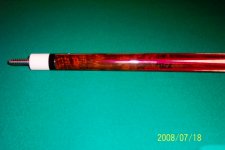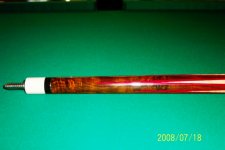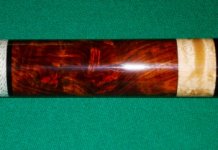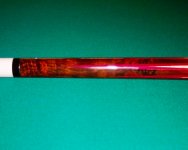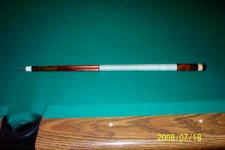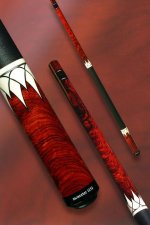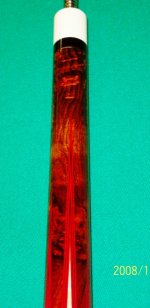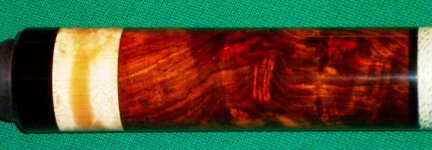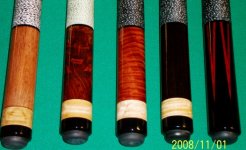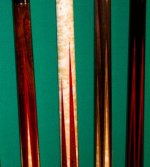Dave that is a great photo but is that SNOW on the ground?
You are using an out of date browser. It may not display this or other websites correctly.
You should upgrade or use an alternative browser.
You should upgrade or use an alternative browser.
Cocobolo Burl does it exist?
- Thread starter CocoboloCowboy
- Start date
dave sutton
Banned
its the only pic of bigfoot i could find with trees. i as making the joke that cocobolo burl exists only where bigfoot and the loch ness monster live. i dont know id the snow ruined it or makes it funnier
CocoboloCowboy said:Joey that MW Cue rocks.
Thank you,
This was the rest of it, http://www.webbcues.com/images/cues3/Butterfly-combo,-Titlist-c.html
Last edited:
I'm sorry if I'm out of line here but I think we've yet to see coco burl.
Mike's cue is absolutely stunning and since he's the builder he can tell his story anyway he likes. I'm just not convinced that it's burl. I want to state clearly that I have the utmost respect for Mike, his work and his abilities but maybe more examples are needed for comparison.
Does the illusive coco burl even exist?
Mike's cue is absolutely stunning and since he's the builder he can tell his story anyway he likes. I'm just not convinced that it's burl. I want to state clearly that I have the utmost respect for Mike, his work and his abilities but maybe more examples are needed for comparison.
Does the illusive coco burl even exist?
Manwon that is a VCC (very Cool Cue)
KJ Cues said:I'm sorry if I'm out of line here but I think we've yet to see coco burl.
Mike's cue is absolutely stunning and since he's the builder he can tell his story anyway he likes. I'm just not convinced that it's burl. I want to state clearly that I have the utmost respect for Mike, his work and his abilities but maybe more examples are needed for comparison.
Does the illusive coco burl even exist?
Thanks KJ as I do you, and you are correct but if it existed, I would hope it looked along the line of the piece I displayed.
Michael Webb said:Thanks KJ as I do you, and you are correct but if it existed, I would hope it looked along the line of the piece I displayed.
the cocobolo guy has one half the size of a vw..... he wont cut it up as
hes been trying to get someone to veneer it.
merylane said:the cocobolo guy has one half the size of a vw..... he wont cut it up as
hes been trying to get someone to veneer it.
He's got to sleep sometime,
Here are couple of more photo's of Cocobolo Burl used in a Billy webb Cue.
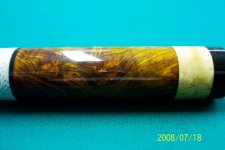
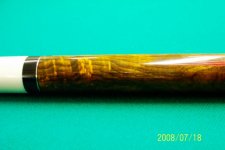
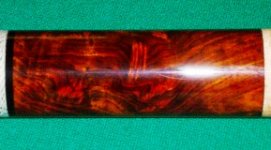
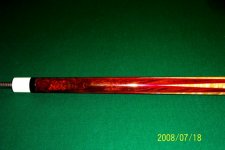
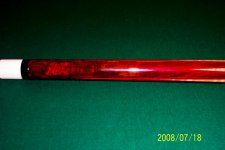
Sorry to beat this horse, but this is Cocobolo Burl, if some one whats to check me out contact Billy webb or Spiderwebb here on the forum. I am sorry for the poor photo's, but it is the best I can do currently. If some one thinks it is not please identify this wood.
Take Care





Sorry to beat this horse, but this is Cocobolo Burl, if some one whats to check me out contact Billy webb or Spiderwebb here on the forum. I am sorry for the poor photo's, but it is the best I can do currently. If some one thinks it is not please identify this wood.
Take Care
i think the Webb is Cocobolo burl.i think most of the other cues are crotch,but the Webb has some pockets or inclusions as burls do.Burl is like a growth or disease on a tree and the wood that comes from it is not as strong as the wood off the tree.it has bark pockets,inclusions and other strange markings.the crotch wood is from tyhe base of a branch and that wood is actually stronger than the wood from the tree.the crotch is stronger b/c it has to support the weight of the branch.it is solid with no pockets or inclusions.
that is my opionion of it anyway.
that is my opionion of it anyway.
masonh said:i think the Webb is Cocobolo burl.i think most of the other cues are crotch,but the Webb has some pockets or inclusions as burls do.Burl is like a growth or disease on a tree and the wood that comes from it is not as strong as the wood off the tree.it has bark pockets,inclusions and other strange markings.the crotch wood is from tyhe base of a branch and that wood is actually stronger than the wood from the tree.the crotch is stronger b/c it has to support the weight of the branch.it is solid with no pockets or inclusions.
that is my opionion of it anyway.
Thanks Mason, While I certainly do not have as much knowledge as others on this board, Billy Webb certainly does. Billy always uses high grade Luthier Woods in his cues, and his knowledge of these woods is top notch. Billy told me that the wood in the cue was Cocobolo Burl, and he explained how rare this wood really is. I am not surprised that many here would have problems beleiving that is what it is, simple because they have seen it before.
Thanks Mason
Last edited:
Oh...and on the subject of burls.... There's no way anyone here can tell me, this is $35,000 worth of amboyna burl. I don't know if it's worth $35,000 inclusive of labor either but....
By the way...can anyone tell me what exactly "burl" is?
http://www.sarasotarockers.com/amboynaburl.htm

By the way...can anyone tell me what exactly "burl" is?
http://www.sarasotarockers.com/amboynaburl.htm

Retail1LO said:Oh...and on the subject of burls.... There's no way anyone here can tell me, this is $35,000 worth of amboyna burl. I don't know if it's worth $35,000 inclusive of labor either but....
By the way...can anyone tell me what exactly "burl" is?
http://www.sarasotarockers.com/amboynaburl.htm

I figured a web page explanation would do better than I could. Here ya go.
Burl wood is a type of fast growing, abnormal growth found on some trees. Burl wood grows because the tree has experienced some sort of environmental stress or damage. This is often caused by either a fungal attack or an attack by insects.
The number of trees that produce burl wood is quite low. In addition, certain areas tend to create more burl wood than others, because all or many of the trees in a particular location are likely to be attacked by the same fungus or insects. Certain species also tend to be more susceptible to attacks and, therefore, more likely to develop burl wood. For this reason, certain types of burl wood are more rare and prized than others.
Often, a tree that has developed burl wood is still quite healthy. In fact, many trees with burl wood can go on to live for many more years. Other trees develop burl wood offshoots that are so large and heavy that they create additional stress on the tree and can cause the tree to die.
When used in woodcrafting, burl wood is removed from the tree, preferably after the tree has already died in order to avoid killing the tree. It is then cut open in order to review the pattern inside. Sometimes, a single burl wood offshoot can produce several different pieces for an artist to work with.
Some burl wood offshoots develop regular growth rings that simply grow at an accelerated rate. This type of burl wood is not as sought after by artists as other forms of burl wood, because the patterns on this wood are not as interesting to look at. The majority of woodworking artists prefer burl wood that grows in irregular patterns that swirl and contain what are referred to as eyes ? small spots that develop on the wood. While pieces with unusual patterns are the most desired form of burl wood, they are also the most difficult to work with. This is because the irregular patterns of burl wood make it harder to saw, chisel, and cut without splitting the wood or accidentally cutting it in the wrong direction.
dave sutton
Banned
burle wood is not very structurally sound. always needs cored. if not when you hit a ball it would just break apart. thats a great chair but it would be funny if someone was rocking in it and it just fell apart...lolol
mullyman said:I figured a web page explanation would do better than I could. Here ya go.
Thank you for that, sir.
kgeorgia said:IMO this is the best example of cocobolo burl on a cue:
That is an extraordinary piece of wood you have there. Almost unbelievable.
Dick
The McWorter in post # 37 ROCKS.


